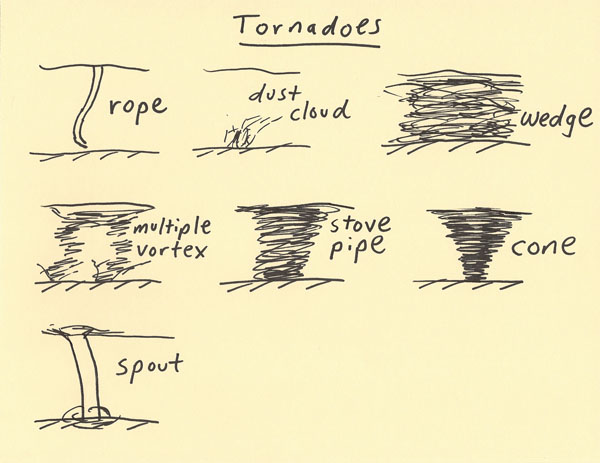
The diagram below shows several of the names that are used to describe how a tornado looks. Each term has a description of the term.  ROPE: A rope tornado can look like this when it is weakening and just before it dissipates. It may look like this when developing but typically it is more likely to look like a rope when it is dissipating. DUST CLOUD: A dust cloud tornado is common when a tornado is developing. The tornado may not be visible except for the dust and debris being kicked up off the surface. Over time, dust, condensation and debris will fill up the tornado and it will have the classic visible extension from the cloud to the ground. WEDGE: The wedge tornado can look as large or larger in the horizontal as it is in the vertical. Wedge tornadoes can sometimes be difficult to distinguish from a low based thunderstorm especially when it is rain wrapped. These tornados tend to have violent winds and produce damage along a large surface area. They are also very deadly for the same reason that they can be difficult to see in the field and the wind speeds are very violent over a relatively large area. MULTIPLE VORTEX: The multiple vortex tornado has two or more tornadoes that are circulating around each other. Over time the vortices may merge into one tornado. STOVE PIPE: The stove pipe tornado is typically not as wide as a wedge but it still has a wide look. Just like the wedge, the winds can be very violent and a damage path can cover a large surface area. Many killer tornadoes are wedges and stove pipes due to their violence and low visibility. CONE: The cone tornado has the classic photogenic tornado appearance. The base of the tornado is narrow at the surface and widens going aloft. SPOUT: A spout tornado can form over the land (land spout) or over the water (water spout). They tend to be weaker tornadoes but are often very photogenic. A long spout typically extends from aloft to the surface. Notes: 1) Tornadoes can dramatically change appearance over time, even over very short periods of time 2) Several factors can alter the visibility of the tornado including the sun, rain, vegetation, time of day, air quality, buildings and dust. 3) Tornadoes are one of the main reasons that people become interested in weather forecasting and storm chasing |